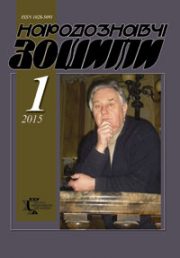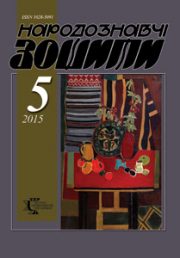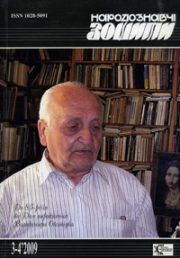The Ethnology Notebooks. 2023. № 6 (174), 1333—1347
UDK 391(=161.2=172:[746.1:677.024](477.8+474.5)”18/20″
DOI https://doi.org/10.15407/nz2023.06.1333
TECHNOLOGIES FOR MAKING LITHUANIAN TRADITIONAL PATTERNED WOVEN APRONS
NYKORAK Оlena
- ORCID ID: https://orcid.org/0000-0003-0887-8929
- Doctor in Art Studies, Professor,
- Leading Researcher,
- Ethnology Institute of the National Academy of Sciences of Ukraine,
- Folk Art Department,
- 15, Svoboda Avenue, 79000, Lviv, Ukraine,
- Contacts: e-mail: olenanykorak@gmail.com
HERUS Lyudmyla
- ORCID ID: https://orcid.org/0000-0002-5931-3816
- Doctor in History Sciences, Сandidate of Аrt Studies (Ph.D.),
- Leading Researcher, Head of Department,
- Ethnology Institute of the National Academy of Sciences of Ukraine,
- Folk Art Department,
- 15, Svoboda Avenue, 79000, Lviv, Ukraine,
- Contacts: e-mail: ludmilagerus@gmail.com
KUTSYR Tetiana
- ORCID ID: https://orcid.org/0000-0002-6522-0640
- Candidate of Art Studies (Ph.D.)
- Researcher,
- Ethnology Institute of the National Academy of Sciences of Ukraine,
- Folk Art Department,
- 15, Svoboda Avenue, 79000, Lviv, Ukraine,
- Contacts: e-mail: sonechko_29@ukr.net
Abstract. Introduction. The article was written based on the results of the Ukrainian-Lithuanian project «Unique technologies of ethnographic textiles: conservation experience in western Ukraine and Lithuania». The article is devoted to the main features of the traditional Lithuanian aprons making. The study of Lithuanian aprons was carried out during the realization of the second stage of the Ukrainian-Lithuanian interdisciplinary scientific research project «Unique Technologies of Ethnographic Textile: Experience of Preservation in Western Ukraine and Lithuania» in 2023. To investigate this issue, scientists made a trip to the village of Šešupės Vilkaviškis District, Kaunas County, where certified traditional weaving craftswoman Janina Blažukienė works. She makes aprons according to the technologies that were widespread in Lithuania at the end of the XIX — in the first half of the XX century. The relevance of the publication is due to the insufficient coverage of Lithuanian traditional woven under waist wear in Ukrainian-language literature, as well as the possibility of applying the acquired knowledge to preserve and develop weaving traditions in Ukraine.
The article’s purpose consists of an analysis of the making principles of Lithuanian traditional patterned aprons, the originality of their decor, and ornamental patterns. Special attention is paid to Suvalkija aprons — a unique phenomenon of Lithuanian weaving.
The object of the study is the traditional patterned woven aprons of all historical and geographical regions of Lithuania: Aukštaitija, Žemaitija, Dzūkija, Lithuania Minor, special attention is paid to monuments from Suvalkija, and the subject of the study is the technological parameters of aprons` making, features of their decor and ornamental patterns.
During the study of Lithuanian traditional aprons, the methods of empirical (observation, experiment, description) and theoretical investigation were applied — comparative-historical, art study, and structural analysis, as well as the method of systematization.
Results. During the realization of the second stage of the project in 2023, Ukrainian and Lithuanian scientists conducted a study on Lithuanian traditional patterned aprons. The aprons of Suvalkija are considered to be the most original ornamentally and colorfully saturated. Their colorful motifs were made using the technique of float techniques on the warp of weaving. In their decor, the lily motif is often used in a variety of mirror-symmetrical and asymmetrical configurations.
Conclusion. Traditional Lithuanian weaving masters, one of them is J. Blažukiene, painstakingly reproduce the main decoration principles of the Lithuanian historical and ethnographic regions aprons. In the preservation and development of traditional technologies for Lithuanian ethnographic textiles techniques, state support, in particular, scholarships, contests, etc., is of great importance. The conducted study on the preservation of unique weaving technologies showed the effectiveness of such measures in Lithuania, which suggests that the introduction of similar methods of stimulation will have a positive result in Ukraine as well.
Keywords: Ukraine, Lithuania, weaving, traditional clo-thing, aprons, study, project.
Received 8.11.2023
REFERENCES
- Nykorak, O., Kutsyr, T., Kumpikaite, E., Milasiene, D., Rukuiziene, Z., & Nenartaviciute, E. (2020). Western Ukrainian and Lithuanian Bedspreads: Decor Ethno-Artistic Tradition Parallels. The Ethnology Notebooks, 1 (151), 60—92 [in Ukrainian].
- Nykorak, O., & Kutsyr, T. (2022). Overshot Western Ukrainian and Lithuanian Coverlets: Ethno-
- Artistic Parallels. The Ethnology Notebooks, 6 (168), 1367—1376 [in Ukrainian].
- Kumpikaite, E., Nykorak, O., Nenartaviciute, E., Herus, L., Kutsyr, T., Milasiene, D.,
- Kozakevych, O., & Rukuiziene, Z. (2023). Comparative Analysis of Western Ukrainian and Lithuanian Folk Towels. Fiber & Textile in Eastern Europe, 2 (31), 26—38.
- Kumpikaite, E., Nykorak, O., Nenartaviciute, E., Herus, L., Kutsyr, T., Kozakevych, O.,
- Milasiene, D., & Rukuiziene, Z. (2022). Similarities and Differences of Lithuanian and Western Ukrainian Folk Towels. In: AUTEX 2022 Conference Proceedings (Pp. 186—190). Lodz.
- Nykorak, O., Kumpikaite, E., Milasiene, D., & Rukuiziene, Z. (2023). Traditional Towels of Western Ukraine and Lithuania: Common and Distinctive Features of the Decor. The Ethnology Notebooks, 3 (171), 742—776 [in Ukrainian].
- Herus, L., Kumpikaite, E., & Nenartaviciute, E. (2023). Towel Function: Comparative Analysis of Ukrainian and Lithuanian Traditions. The Ethnology Notebooks, 3 (171), 777—791 [in Ukrainian].
- Kutsyr, T., Milasiene, D., & Rukuiziene, Z. (2023). Embroidery in Traditional Woven Towels of the Western Part of Ukraine and Lithuania: Comparative Aspect. The Ethnology Notebooks, 3 (171), 792—804 [in Ukrainian].
- Nykorak, O., Herus, L., & Kutsyr, T. (2022). Patterned Woven Sashes of Western Ukrainian and
- Lithuania: Techniques, Ornamentation, Functions. The Ethnology Notebooks, 5 (167), 1147—1163 [in Ukrainian].
- Bernotiene, S. (1974). Lithuanian Folk Women’s Clothing of the XVIIIth — XXth centuries. Vilnius: Mintis [in Lithuanian].
- Tomkuviene, D. (2013). Traditional Clothing of Kaisiadoris Area. Vilnius [in Lithuanian].
- Bernotaite-Beliauskiene, D., & Rutkauskiene, R. (2017). Traditional Clothing and the National
- Costume: Textiles, Graphics, Painting. Vilnius: Lietuvos dailės muziejus [in Lithuanian].
- Jurkuviene, T. (2006). Lietuviu tautinis kostiumas. Vilnius: Baltos lankos [in Lithuanian].
- Kavaliauskiene, A. (2017). Western Lithuanian Historical Costume of the XV — the First Half of the XX Century. Mazosius Lietivos istorijos muziejus [in Lithuanian].
- Savoniakaite, V. (1998). Textile in Rural Culture. Lithuanian Geometric Patterns in the XIX and XX Centuries. Vilnius: Alma littera [in Lithuanian].
- Jurkuviene, T. (1999). Lily Motif in Lithuanian Folk Textiles. In: Ancient Baltic culture, 5, 248—261 [in Lithuanian].
- Tumenas, V. (2002). Ornament of Lithuanian Traditional Pick-Up Woven Sashes. Vilnius:
- Diemedis [in Lithuanian].
- Katkuviene, D., & Vandyte, A. (Eds.) (2008). Aprons of Suvalkija. Catalogue. Marijampole: Piko valanda leidykla [in Lithuanian].
- Holovatskii, Ja. (1868). About the Costumes or Folk Clothing of Rusyns or Russians in Galicia
- and North-Eastern Hungary. Petrograd: A. Kraievskii Printing House [in Russian].
- Lu, J., & Zhao, F. (2021). French Silk Varieties in Eighteenth Century. Asian Social Science, 1 (Vol. 17, pp. 53—61).
- Lebednykaite, M. (2013). Festive Aprons in the Lithuanian Culture. 19th Century — Early 20Th Century. Doctoral Dissertation. Vilnius: Vilniaus dailės akademija [in Lithuanian].
- Lithuanian National Culture Centre. About Us. Retrieved from: https://www.lnkc.lt/go.php/eng/About-us-/8781 (Last accessed: 30.10.2023).
- Paskelbti geriausi liaudies menininkai. Retrieved from: https://alkas.lt/2023/01/10/paskelbti-
- geriausi-liaudies-menininkai/ (Last accessed: 30.10.2023).
- Gutauskiene, M. (2023). Republican Competitive Folk Art Exhibition. 2022. Catalogue. Gelgaudiskis [in Lithuanian].
- The history of Zypliai Manor. Retrieved from: https://zypliudvaras.lt/?cat=3 (Last accessed: 30.10.2023).
- John Hill. Modernist Kaunas Added to UNESCO World Heritage List. 25. September 2023.
- Retrieved from: https://www.world-architects.com/en/architecture-news/headlines/modernist-kaunas-added-to-unesco-world-heritage-list (Last accessed: 30.10.2023).
- Modernist Kaunas: Architecture of Optimism, 1919—1939. Retrieved from: https://whc.unesco.org/en/list/1661/ (Last accessed: 30.10.2023).






